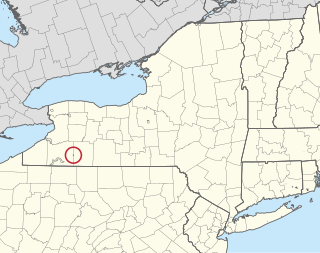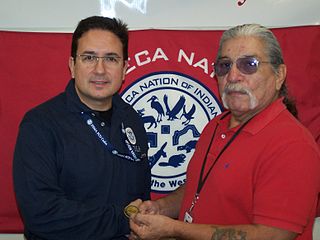Related Research Articles

Oil Springs Reservation or Oil Spring Reservation is an Indian reservation of the federally recognized Seneca Nation that is located in southwestern New York, United States. As of the 2010 census, the Indian reservation had one resident; in 2005 no tribal members had lived on the property. The reservation covers about one square mile (2.6 km2), divided between the present-day counties of Allegany and Cattaraugus. The reservation is northwest of the village of Cuba. It is bordered by the Town of Cuba and the Town of Ischua.

Salamanca is a city in Cattaraugus County, New York, United States, inside the Allegany Indian Reservation, one of two governed by the Seneca Nation of New York. The population was 5,929 at the 2020 census. It was named after José de Salamanca, a Spanish nobleman and cabinet minister of the mid-19th century.
The Seneca are a group of Indigenous Iroquoian-speaking people who historically lived south of Lake Ontario, one of the five Great Lakes in North America. Their nation was the farthest to the west within the Six Nations or Iroquois League (Haudenosaunee) in New York before the American Revolution.

The Holland Land Company was an unincorporated syndicate of thirteen Dutch investors from Amsterdam, headquartered in Philadelphia, who purchased large tracts of American land for development and speculation. Their primary purchase was that of the western two-thirds of the Phelps and Gorham Purchase in 1792 and 1793, an area that afterward was known as the Holland Purchase. Additional lands were purchased in northwest Pennsylvania. Aliens were forbidden from owning land within New York State, except by special acts of the New York State Legislature, so investors placed their funds in the hands of certain trustees who bought the land in central and western New York State. The syndicate hoped to sell the land rapidly at a great profit. Instead, for many years they were forced to make further investments in their purchase; surveying it, building roads, digging canals, to make it more attractive to settlers. They influenced state policy in New York to allow foreign ownership of the land, avoid new taxes, and promote the construction of the Erie Canal and government roads on the company lands. They supported Governor Dewitt Clinton's faction in the state government to achieve these goals. The company finished selling its New York lands in 1839 and its Pennsylvania lands in 1849, and the company was liquidated in 1858.
The Nonintercourse Act is the collective name given to six statutes passed by the Congress in 1790, 1793, 1796, 1799, 1802, and 1834 to set Amerindian boundaries of reservations. The various Acts were also intended to regulate commerce between settlers and the natives. The most notable provisions of the Act regulate the inalienability of aboriginal title in the United States, a continuing source of litigation for almost 200 years. The prohibition on purchases of Indian lands without the approval of the federal government has its origins in the Royal Proclamation of 1763 and the Confederation Congress Proclamation of 1783.
The economy of the Haudenosaunee historically was based on communal production and combined elements of both horticulture and hunter-gatherer systems. Some have described the Iroquois economy as primitive communism. The tribes of the Iroquois Confederacy and other Northern Huron had their traditional territory in what is now New York State and the southern areas bordering the Great Lakes. The confederacy was originally composed of five tribes; the Mohawk, Onondaga, Oneida, Cayuga, and Seneca, who had created an alliance long before European contact. The Tuscarora were added as a sixth nation in the early eighteenth century after they migrated from North Carolina. The Huron peoples, located mostly in what is now Canada, were also Iroquoian-speaking and shared some culture, but were never part of the Iroquois.
There are four treaties of Buffalo Creek, named for the Buffalo River in New York. The Second Treaty of Buffalo Creek, also known as the Treaty with the New York Indians, 1838, was signed on January 15, 1838 between the Seneca Nation, Mohawk nation, Cayuga nation, Oneida Indian Nation, Onondaga (tribe), Tuscarora (tribe) and the United States. It covered land sales of tribal reservations under the U.S. Indian Removal program, by which they planned to move most eastern tribes to Kansas Territory west of the Mississippi River.

The Cayuga Nation of New York is a federally recognized tribe of Cayuga people, based in New York, United States. Other organized tribes with Cayuga members are the federally recognized Seneca-Cayuga Tribe of Oklahoma and the Canadian-recognized Six Nations of the Grand River First Nation in Ontario, Canada.
The Tonawanda Seneca Nation is a federally recognized tribe in the State of New York. They have maintained the traditional form of government led by sachems selected by clan mothers. The Seneca are one of the original Five Nations of the Haudenosaunee or Iroquois Confederacy. Their people speak the Seneca language, an Iroquoian language.
Irving is a hamlet in Chautauqua County, New York, United States. It is located near the eastern town line and the eastern county line in the town of Hanover. U.S. Route 20 and New York State Route 5 pass through the hamlet, which is next to Cattaraugus Creek; New York State Route 438 terminates just across the creek. The elevation of the hamlet is 584 feet (178 m) above sea level. The ZIP Code for Irving is 14081.
Canawaugus was a Seneca Indian village. The village was located on the west side of the Genesee River, "about a mile above the ford", on the eastern edge of the Town of Caledonia. It was nearly opposite of the Avon sulphur springs. The name means "stinking waters" because of the sulphur.

The Buffalo Creek Reservation was a tract of land surrounding Buffalo Creek in the central portion of Erie County, New York. It contained approximately 49,920 acres (202.0 km2) of land and was set aside for the Seneca Nation following negotiations with the United States after the American Revolutionary War.

The Seneca Nation of Indians is a federally recognized Seneca tribe based in western New York. They are one of three federally recognized Seneca entities in the United States, the others being the Tonawanda Band of Seneca and the Seneca-Cayuga Nation of Oklahoma. Some Seneca also live with other Iroquois peoples on the Six Nations of the Grand River in Ontario.
Seneca Nation of Indians v. Christy, 162 U.S. 283 (1896), was the first litigation of aboriginal title in the United States by a tribal plaintiff in the Supreme Court of the United States since Cherokee Nation v. Georgia (1831). It was the first such litigation by an indigenous plaintiff since Fellows v. Blacksmith (1857) and its companion case of New York ex rel. Cutler v. Dibble (1858). The New York courts held that the 1788 Phelps and Gorham Purchase did not violate the Nonintercourse Act, one of the provisions of which prohibits purchases of Indian lands without the approval of the federal government, and that the Seneca Nation of New York was barred by the state statute of limitations from challenging the transfer of title. The U.S. Supreme Court declined to review the merits of lower court ruling because of the adequate and independent state grounds doctrine.
Fellows v. Blacksmith, 60 U.S. 366 (1857), is a United States Supreme Court decision involving Native American law. John Blacksmith, a Tonawanda Seneca, sued agents of the Ogden Land Company for common law claims of trespass, assault, and battery after he was forcibly evicted from his sawmill by the Company's agents. The Court affirmed a judgement in Blacksmith's favor, notwithstanding the fact that the Seneca had executed an Indian removal treaty and the Company held the exclusive right to purchase to the land by virtue of an interstate compact ratified by Congress.
New York ex rel. Cutler v. Dibble, 62 U.S. 366 (1858), was a companion case to the more well-known Fellows v. Blacksmith (1857). At the time Fellows was decided, this case had reached the U.S. Supreme Court but had not yet been argued.

Aboriginal title in New York refers to treaties, purchases, laws and litigation associated with land titles of aboriginal peoples of New York, in particular, to dispossession of those lands by actions of European Americans. The European purchase of lands from indigenous populations dates back to the legendary Dutch purchase of Manhattan in 1626, "the most famous land transaction of all." More than any other state, New York disregarded the Confederation Congress Proclamation of 1783 and the follow-on Nonintercourse Acts, purchasing the majority of the state directly from the Iroquois nations without federal involvement or ratification.

An Organic Act is a generic name for a statute used by the United States Congress to describe a territory, in anticipation of being admitted to the Union as a state. Because of Oklahoma's unique history an explanation of the Oklahoma Organic Act needs a historic perspective. In general, the Oklahoma Organic Act may be viewed as one of a series of legislative acts, from the time of Reconstruction, enacted by Congress in preparation for the creation of a united State of Oklahoma. The Organic Act created Oklahoma Territory, and Indian Territory that were Organized incorporated territories of the United States out of the old "unorganized" Indian Territory. The Oklahoma Organic Act was one of several acts whose intent was the assimilation of the tribes in Oklahoma and Indian Territories through the elimination of tribes' communal ownership of property.
On the eve of the American Civil War in 1861, a significant number of Indigenous peoples of the Americas had been relocated from the Southeastern United States to Indian Territory, west of the Mississippi. The inhabitants of the eastern part of the Indian Territory, the Five Civilized Tribes, were suzerain nations with established tribal governments, well established cultures, and legal systems that allowed for slavery. Before European Contact these tribes were generally matriarchial societies, with agriculture being the primary economic pursuit. The bulk of the tribes lived in towns with planned streets, residential and public areas. The people were ruled by complex hereditary chiefdoms of varying size and complexity with high levels of military organization.

Maris Bryant Pierce, was a Seneca Nation chief, lawyer, and teacher. He was a tribal land-rights activist, and a major influence to the Second Treaty of Buffalo Creek of 1838.
References
- Laurence M. Hauptman, Conspiracy of Interests: Iroquois Dispossession and the Rise of New York State (2001).